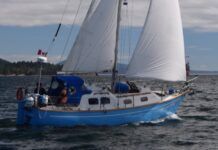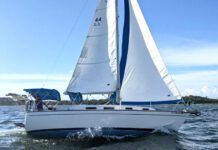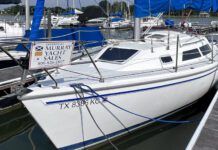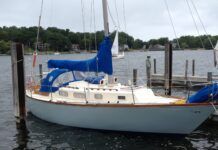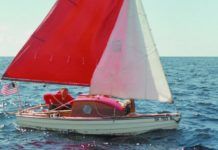Vancouver 27 Used Boat Review
I was single handed on our Islander Bahama 30 on a spectacular fall afternoon, white caps dancing on the blue waters of Plumper Sound...
Pearson 303 Used Boat Review
The Pearson 303 is a big 30-footer, intended for safe coastal cruising. She admirably succeeds in doing what she was designed to do. The only risk accrues to those who mistake her for something she is not -- an offshore, passage-making boat. While it’s easy to overlook the Pearson 303 as another member of a fleet that looks depressingly similar and lacking in pizzazz, the 303 is a wholesome family cruiser with a workable, traditional interior, acceptable performance and above average construction. Hey, what’s not to like?
Grampian 26 Used Boat Review
The first fiberglass auxiliary sailboats were built in the late 1950s. The burgeoning industry reached full bloom in the early 1970s, but the 1960s saw a rapid increase in the number of builders hoping to cash in on the new miracle material of fiberglass. No seams, no rot, no water absorption...or so we thought. Still, the claims were largely accurate, and even though the ad agencies were quick with hyperbole, the public bought it. By 1961, a handful of European builders were also working with woven glass fibers and polyester resin, laying up hulls in female molds. In Canada, one of the first was Grampian Marine Limited of Oakville, Ontario.
Catalina 270 vs. The Beneteau First 265 Used Boat Match-Up
Two of the newest 27-foot cruising boat designs are from Beneteau and Catalina, both huge builders. Checking out both boats at a recent show, we noticed that the base list price of the Beneteau First 265 with inboard ($38,050) was less than 10 percent above the base for the Catalina 270 LE ($34,775). Their Euro-styled interior layouts were at least superficially similar as well, as were hull and sail plan dimensions. Which boat, we wondered, is the better buy, and for whom?
Tartan 30: An Affordable Classic
The early 1970s was the heyday of the Tartan 30' racer/cruiser. In all, no less than two dozen boats of a similar size and type were introduced in just three years, many of them to become highly successful among sailors eager for the performance and amenities of big boats at a modest price. Among the most noteworthy and enduring of the 30-footers from this era has been the Tartan 30.
4 Types of Pocket Cruisers
The recent release of Steve Wystrachs outstanding documentary film Manry at Sea about Robert Manry, the former copy editor who sailed across the Atlantic in a 13-foot sailboat, got me thinking again about the virtues of small cruising boats. In my view, there are at least four main types of pocket cruisers. Manrys modified lake boat fits somewhere in between the first two.
Drawing the Line on Boat Design
A New Zealander greatly influenced by the traditional craft of the Pacific and Indian Oceans, famed multihull designer Ian Farrier understood that an enduring design goes through several evolutions. Proas, the small sailing craft of Micronesia that inspired his visionary folding trimaran design, presented a perfect example of this.
Stiletto 27: The Beachcat Grown Up
Its hard to mistake the Stiletto 27s appearance-typically with blazing topside graphics and aircraft-style, pop-top companionway hatches. Its also hard for the average sailor to appreciate the sophistication of the Stilettos construction-epoxy-saturated fiberglass over a Nomex honeycomb core. There is probably no production hull built in the U.S. with a better strength-to-weight ratio than the Stiletto. And although the design is 40 years old, the Nomex honeycomb fabrication is still impressive.
Stiletto Foiler on Horizon
This summer, Stiletto Manufacturing will be launching the all-new Stiletto X-Series, including a foiling catamaran, with the first boats expected to splash about the time this article went press. Carrying on the Stiletto tradition, the 10-meter X-Series models are being marketed as high-performance boats that are fast, beachable, trailerable, and affordable, as well as easy to handle and ideal for coastal family getaways.
Dragonfly 800
The Dragonfly 800 comes in two configurations, one for racing and one for what the company calls cruising, which is a misnomer only in that it implies a plodding demeanor, which is hardly the case. The essential difference is a taller mast and Kevlar sails for the racing model.





































